Shankar IAS Summary: Functions of An Ecosystem | Famous Books for UPSC Exam (Summary & Tests) PDF Download
| Table of contents |

|
| Energy Flow |

|
| Pollutants and Trophic Level |

|
| Biotic Interaction |

|
| Biogeochemical Cycle |

|
| Succession |

|
Energy Flow
Energy is the basic force responsible for all metabolic activities. The flow of energy from producer to top consumers is called energy flow which is unidirectional.
- Energy flows through the trophic levels: from producers to subsequent Trophic levels.
- There is a loss of some energy in the form of unusable heat at each trophic level.
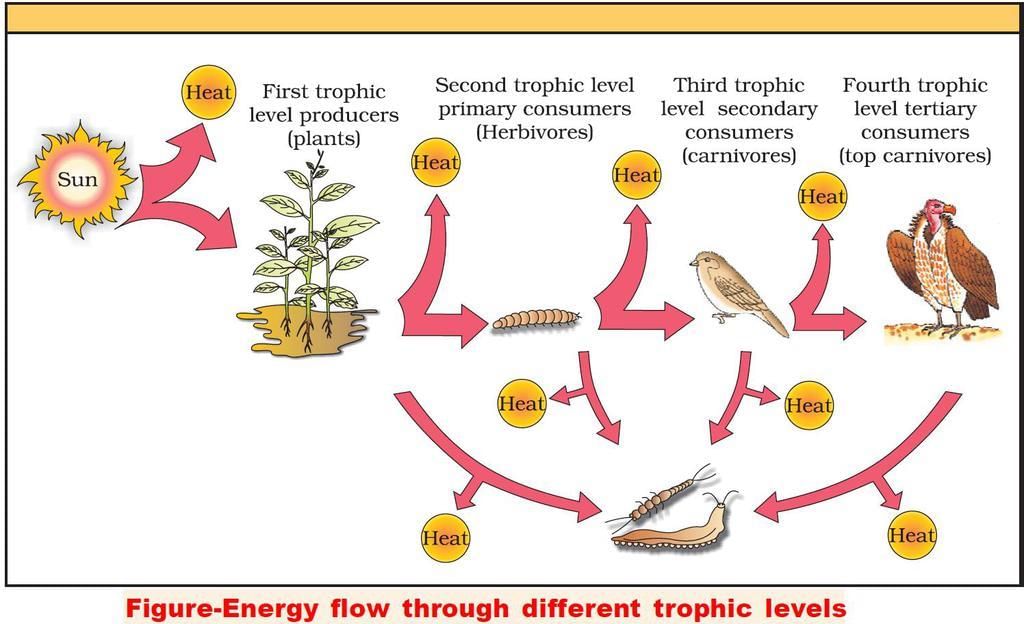
The trophic level interaction involves three concepts:
1. Food Chain -
A food chain starts with producers and ends with top carnivores. The sequence of eaten and being eaten produces transfer of food energy and it is known as food chain.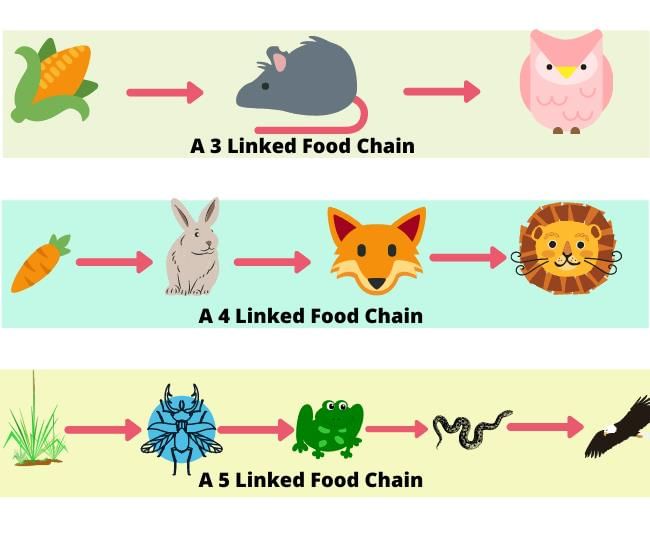
- Grazing food chain - The consumers which start the food chain, utilising the plant or plant part as their food, constitute the grazing food chain. This food chain begins from green plants at the base and the primary consumer is herbivore.
 Example:
Example:
(i) In terrestrial ecosystem, grass is eaten up by caterpillar, which is eaten by lizard and lizard is eaten by snake.
(ii) In Aquatic ecosystem, phytoplankton’s (primary producers) is eaten by zooplanktons which is eaten by fishes and fishes are eaten by pelicans. - Detritus food chain - The food chain starts from dead organic matter of decaying animals and plant bodies to the micro-organisms and then to detritus feeding organism called detritivores or decomposer and to other predators.
Example: Litter - Earthworms - Chicken - Hawk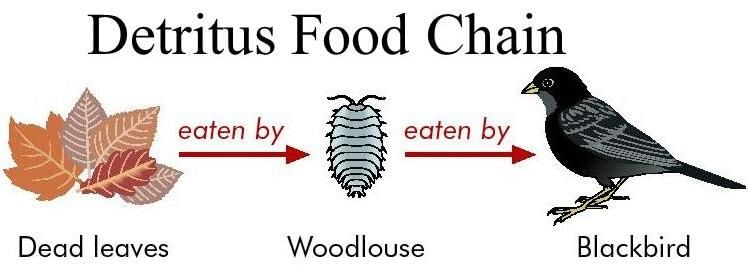
- The distinction between these two food chains is the source of energy for the first level consumers.
2. Food Web:
A food web illustrates, all possible transfers of energy and nutrients among the organisms in an ecosystem, whereas a food chain traces only one pathway of the food.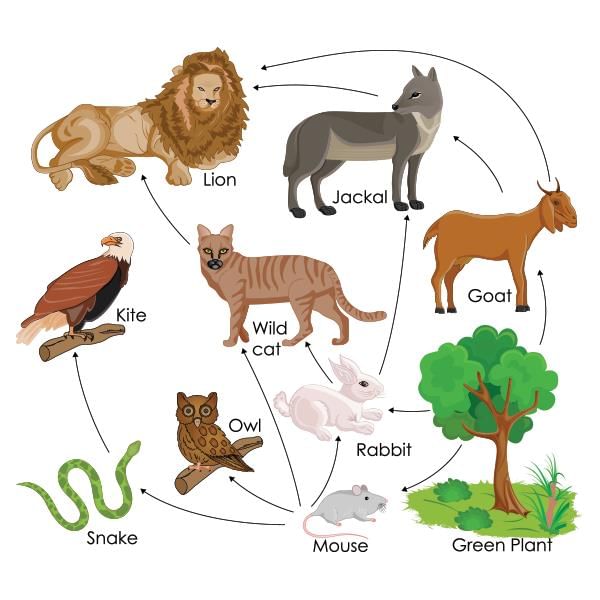 Food web
Food web3. Ecological Pyramid
- The steps of trophic levels expressed in a diagrammatic way are referred to as ecological pyramids.
 Ecological Pyramid
Ecological Pyramid - The food producer forms the base of the pyramid and the top carnivore forms the tip. Other consumer trophic levels are in between.
- The pyramid consists of a number of horizontal bars depicting specific trophic levels which are arranged sequentially from primary producer level through herbivore, carnivore onwards.
- Length of each bar represents the total number of individuals at each trophic level in an ecosystem.
➢ The Ecological Pyramids are of three categories
- Pyramid of numbers.
- Pyramid of biomass.
- Pyramid of energy or productivity.
Ecological pyramid of number, biomass, productivity
(a) Pyramid of Numbers
- This deals with the relationship between the numbers of primary producers and consumers of different levels. Depending upon the size and biomass, the pyramid of numbers may not always be upright, and may even be completely inverted.
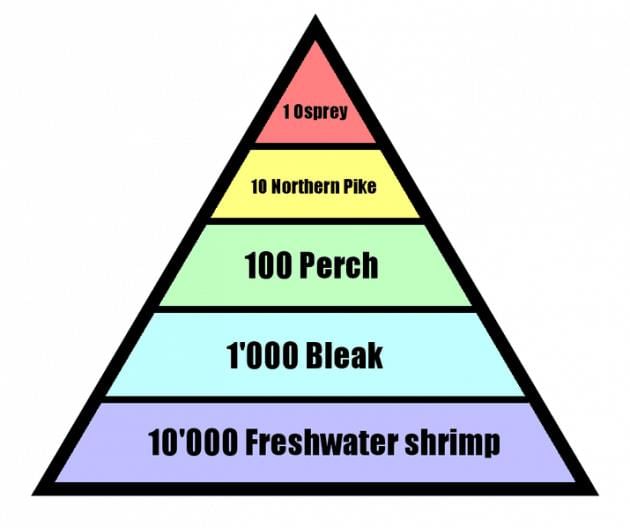 Pyramid of numbers
Pyramid of numbers
(i) Pyramid of numbers- Upright
- In this pyramid, the number of individuals is decreased from lower level to higher trophic level. This type of pyramid can be seen in grassland ecosystem.
(ii) Pyramid of numbers - Inverted
- In this pyramid, the number of individuals is increased from lower level to higher trophic level. A count in a forest would have a small number of large producers.
- Few numbers of big trees. This is because the tree (primary producer) being few in number and would represent the base of the pyramid and the dependent herbivores (Example - Birds) in the next higher trophic level and it is followed by parasites in the next trophic level. Hyper parasites being at higher trophic level represents higher in numbers.
- A pyramid of numbers does not take into account the fact that the size of organisms being counted in each trophic level can vary the pyramid of number does not completely define the trophic structure for an ecosystem.
1. Erosion
2. Biological transport of excreta of marine birds
3. Mountain building
Choose the correct answer using the code given below;
(b) Pyramid of Biomass
- In this approach individuals in each trophic level are weighed instead of being counted. This gives us a pyramid of biomass, i.e., the total dry weight of all organisms at each trophic level at a particular time. Biomass is measured in g/m2.
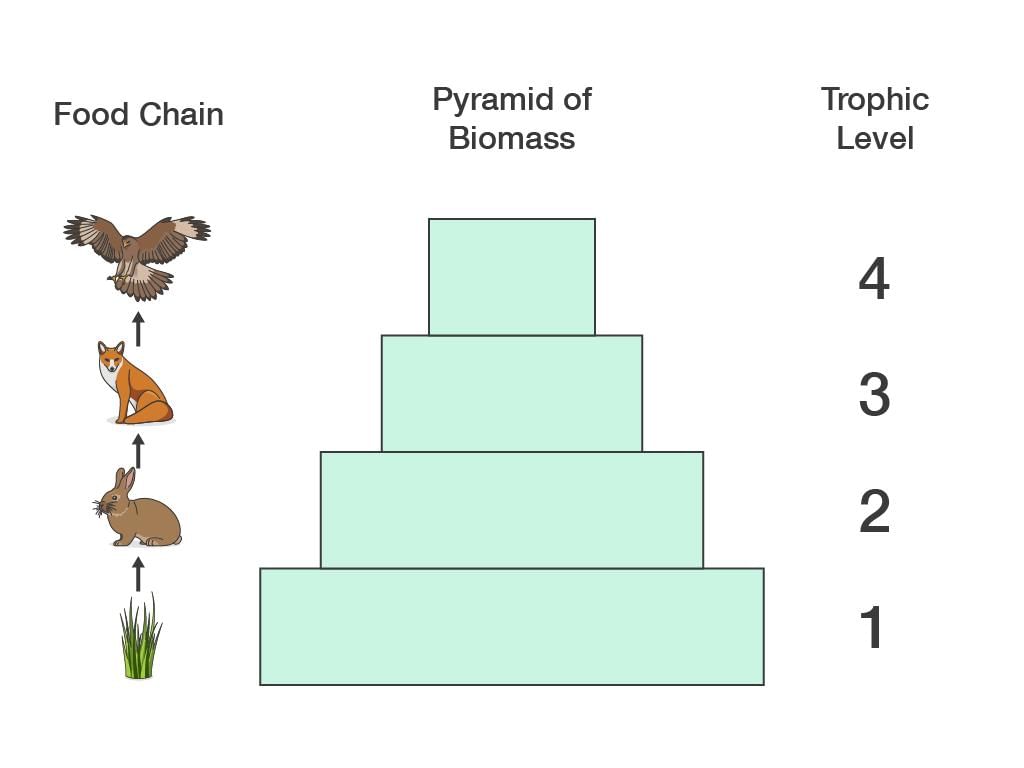 Pyramid of biomass
Pyramid of biomass - Upward pyramid - For most ecosystems on land, the pyramid of biomass has a large base of primary producers with a smaller trophic level perched on top.
- Inverted pyramid - In contrast, in many aquatic ecosystems, the pyramid of biomass may assume an inverted form.
(c) Pyramid of Energy - To compare the functional roles of the trophic levels in an ecosystem, an energy Pyramid is most suitable. An energy pyramid, reflects the laws of thermodynamics, with conversion of solar energy to chemical energy and heat energy at each trophic level and with loss of energy being depicted at each transfer to another trophic level. Hence the pyramid is always upward, with a large energy base at the bottom.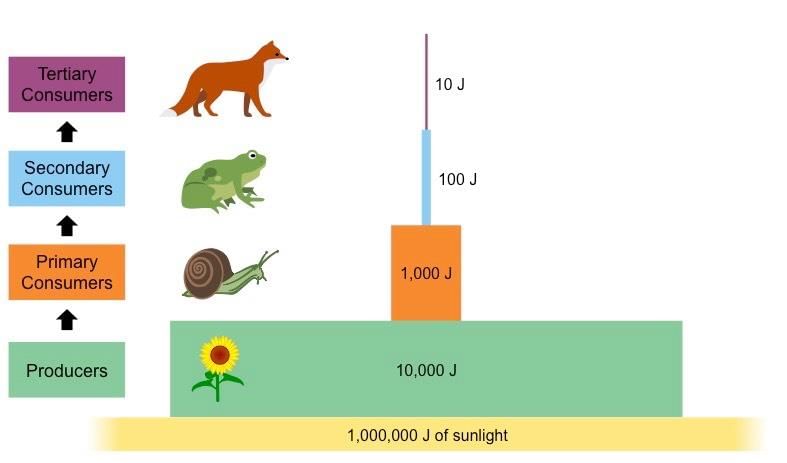 Pyramid of energy
Pyramid of energy
Pollutants and Trophic Level
Movement of these pollutants involves two main processes:
1. Bioaccumulation - refers to how pollutants enter a food chain, there is an increase in the concentration of a pollutant from the environment to the first organism in a food chain.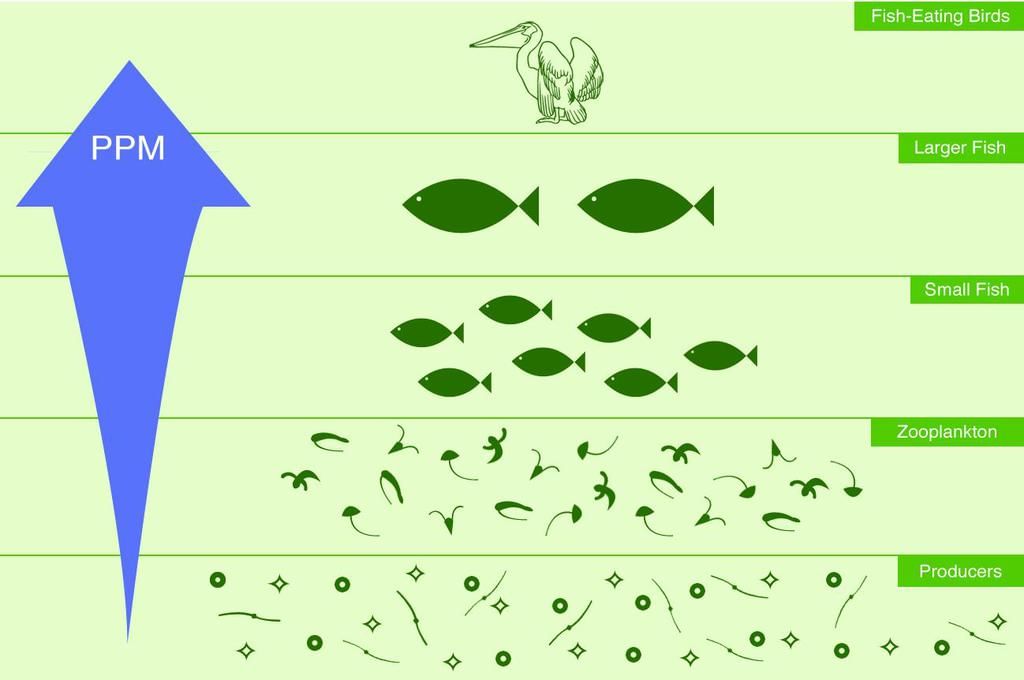 Bioaccumulation
Bioaccumulation
- Refers to the tendency of pollutants to concentrate as they move from one trophic level to the next.

- There is an increase in the concentration of a pollutant from one link in a food chain to another.
- In order for biomagnification to occur, the pollutant must be long-lived, mobile, soluble in fats, biologically active.
- If a pollutant is not active biologically, it may biomagnify, but we really don't worry about it much, since it probably won't cause any problems.
Example: DDT
Biotic Interaction
The interaction between the organisms is fundamental for its survival and functioning of the ecosystem as a whole.
Types of Biotic Interaction
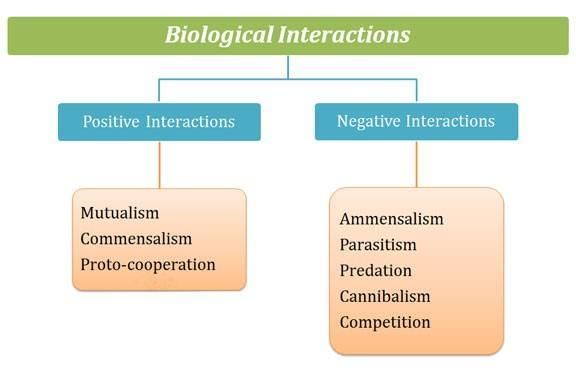
- Mutualism - Both species benefit.
Example: In pollination mutualisms, the pollinator gets food (pollen, nectar), and the plant has its pollen transferred to other flowers for cross-fertilization (reproduction). - Commensalism - One species benefits, the other is unaffected.
Example: Cow dung provides food and shelter to dung beetles. The beetles have no effect on the cows. - Competition - Both species are harmed by the interaction.
Example: If two species eat the same food, and there isn't enough for both, both may have access to less food than they would if alone. They both suffer a shortage of food. - Predation and parasitism - One species benefits, the other is harmed.
Example:
(i) Predation- One fish kills and eats.
(ii) Parasitism- Tick gains benefit by sucking blood, the host is harmed by losing blood. - Amensalism - One species is harmed, the other is unaffected.
Example: A large tree shades a small plant, retarding the growth of the small plant. The small plant has no effect on the large tree. - Neutralism - There is no net benefit or harm to either species. Perhaps in some interspecific interactions, the costs and benefits experienced by each partner are exactly the same so that they sum to zero.
Biogeochemical Cycle
The elements or mineral nutrients are always in circulation moving from non-living to living and then back to the non-living components of the ecosystem in a more or less circular fashion. This circular fashion is known as biogeochemical cycling (bio for living, geo for atmosphere).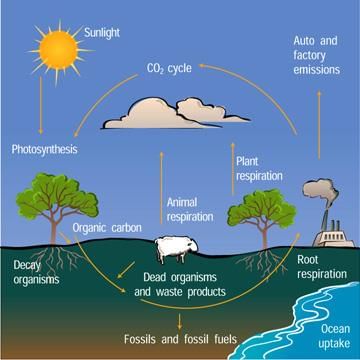 Biogeochemical Cycle
Biogeochemical Cycle
 |
Download the notes
Shankar IAS Summary: Functions of An Ecosystem
|
Download as PDF |
1. Nutrient Cycling
- The nutrient cycle is a concept that describes how nutrients move from the physical environment to the living organisms and subsequently recycled back to the physical environment.
- It is essential for life and it is the vital function of the ecology of any region. In any particular environment, to maintain its organism in a sustained manner, the nutrient cycle must be kept balanced and stable.
➢ Types of Nutrient Cycle
- Based on the replacement period a nutrient cycle is referred to as Perfect or Imperfect cycle.
- A perfect nutrient cycle is one in which nutrients are replaced as fast as they are utilised. Most gaseous cycles are generally considered as perfect cycles. In contrast, sedimentary cycles are considered relatively imperfect, as some nutrients are lost from the cycle and get locked into sediments and so become unavailable for immediate cycling.
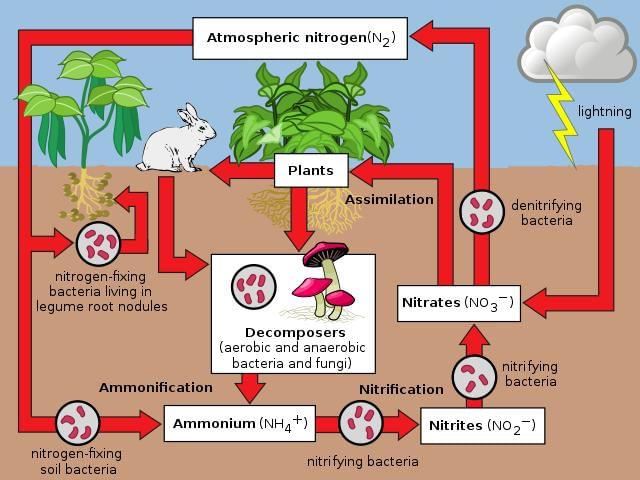 Nutrient Cycle
Nutrient Cycle - Based on the nature of the reservoir, there are two types of cycles namely Gaseous and sedimentary cycle.
- Gaseous Cycle - Where the reservoir is the atmosphere or the hydrosphere.
- Sedimentary Cycle - Where the reservoir is the earth's crust.
2. Gaseous Cycles -
Water Cycle (Hydrologic)- The hydrologic cycle is the continuous circulation of water in the Earth-atmosphere system which is driven by solar energy. Water moves from one reservoir to another by the processes of evaporation, transpiration, condensation, precipitation, deposition, runoff, infiltration, and groundwater flow.
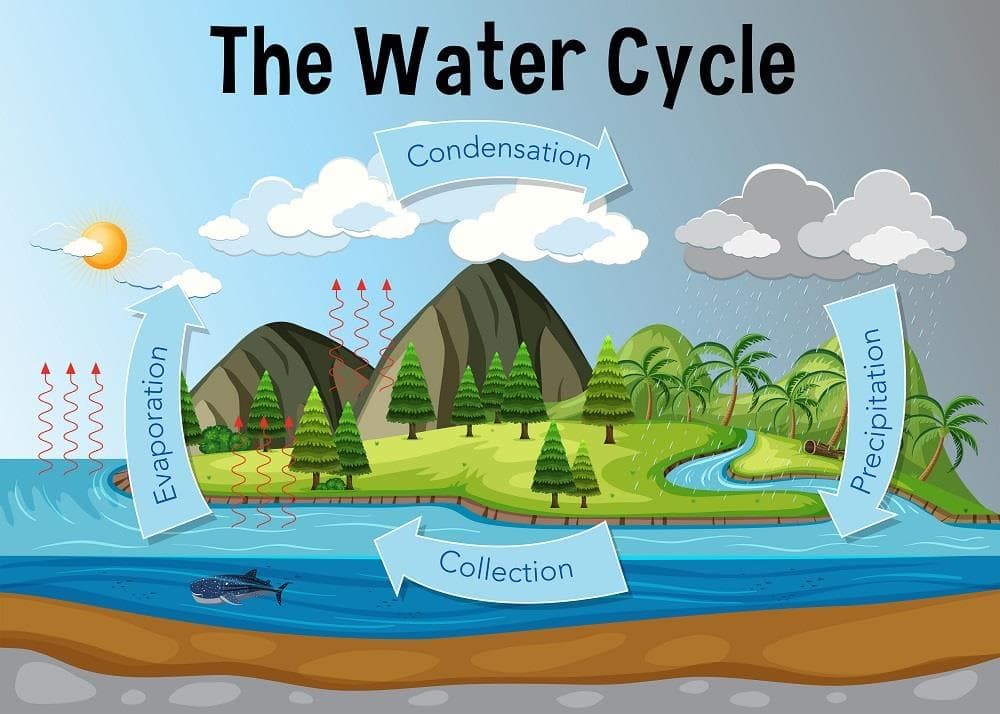
3. The Carbon Cycle
- Without carbon dioxide life could not exist, because it is vital for the production of carbohydrates through photosynthesis by plants. It is the element that anchors all organic substances from coal and oil to DNA.(deoxyribonucleic acid: the compound that carries genetic information).
Carbon Cycle
- Carbon cycle involves a continuous exchange of carbon between the atmosphere and organisms. Carbon from the atmosphere moves to green plants by the process of photosynthesis, and then to animals. By process of respiration and decomposition of dead organic matter, it returns back to the atmosphere.
4. The Nitrogen Cycle
- An essential constituent of protein and is a basic building block of all living tissue. It constitutes nearly 16% by weight of all the proteins.
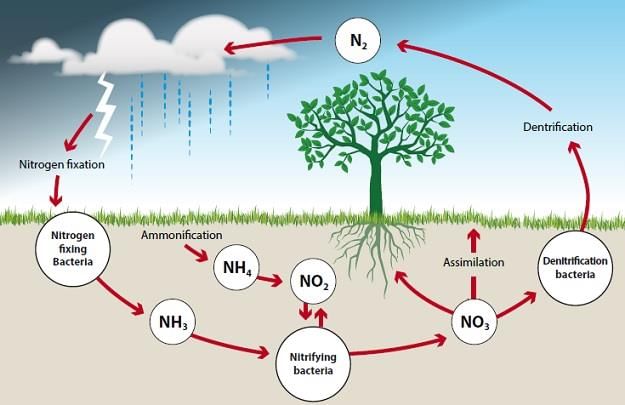 Nitrogen Cycle
Nitrogen Cycle - There is an inexhaustible supply of nitrogen in the atmosphere but the elemental form cannot be used directly by most of the living organism.
- Needs to be ’fixed', that is, converted to ammonia., nitrites or nitrates, before it can be taken up by plants.
- On earth it is accomplished in three different ways: By microorganism (bacteria and blue-green algae) By man using industrial processes (fertilizer factories) and To a limited extent by atmospheric phenomena such as thunder and lighting.
- The amount of Nitrogen fixed by man through the industrial process has far exceeded the amount fixed by the Natural Cycle.
- As a result, Nitrogen has become a pollutant which can disrupt the balance of nitrogen. It may lead to Acid rain, Eutrophication and Harmful Algal Blooms.
- Certain microorganisms are capable of fixing atmospheric nitrogen into ammonium ions. These include free-living nitrifying bacteria (Example: aerobic Azotobacter and anaerobic Clostridium) and symbiotic nitrifying bacteria living in association with leguminous plants (pulse etc.) and symbiotic bacteria.
- Living in non-leguminous root nodule plants (Example: Rhizobium) as well as blue-green algae (Example: Anabaena, Spirulina). Ammonium ions can be directly taken up as a source of nitrogen by some plants, or are oxidized to nitrites or nitrates by two groups of specialised bacteria.
- Nitrosamines bacteria promote the transformation of ammonia into nitrite Nitrite is then further transformed into nitrate by the bacteria Nitrobacter. The nitrates synthesised by bacteria in the soil are taken up by plants and converted into amino acids, which are the building blocks of proteins. These then go through higher trophic levels of the ecosystem.
- During excretion and upon the death of all organisms nitrogen is returned to the soil in the form of ammonia.
- Certain quantity of soil nitrates, being highly soluble in water, is lost to the system by being transported away by surface run-off or groundwater. In the soil as well as oceans there are special denitrifying bacteria (Example: Pseudomonas), which convert the nitrates/nitrites to elemental nitrogen. This nitrogen escapes into the atmosphere, thus completing the cycle.
- The periodic thunderstorms convert the gaseous nitrogen in the atmosphere to ammonia and nitrates which eventually reach the earth's surface through precipitation and then into the soil to be utilized by plants.
5. Sedimentary Cycle
Phosphorus, calcium and magnesium circulate by means of the sedimentary cycle.
1. Pyramid of numbers
2. Pyramid of biomass
3. Pyramid of Energy
4. Pyramid of Productivity
Choose the correct answer using the code given below;
(a) Phosphorus Cycle
- Phosphorus plays a central role in aquatic ecosystems and water quality.

- Phosphorus occurs in large amounts as a mineral in phosphate rocks and enters the cycle from erosion and mining activities.
- This is the nutrient considered to be the main cause of excessive growth of rooted and free-floating microscopic plants in lakes.
- The main storage for phosphorus is in the earth's crust. On land, phosphorus is usually found in the form of phosphates. By the process of weathering and erosion phosphates enter rivers and streams that transport them to the ocean.
- In the ocean, once the phosphorus accumulates on continental shelves in the form of insoluble deposits after millions of years, the crustal plates rise from the seafloor and expose the phosphates on land.
- After more time, weathering will release them from rock and the cycle's geochemical phase begins again.
(b) Sulphur Cycle
- The sulphur reservoir is in the soil and sediments where it is locked in organic coal, oil and peat) and inorganic deposits (pyrite rock and sulphur rock) in the form of sulphates, sulphides and organic sulphur.
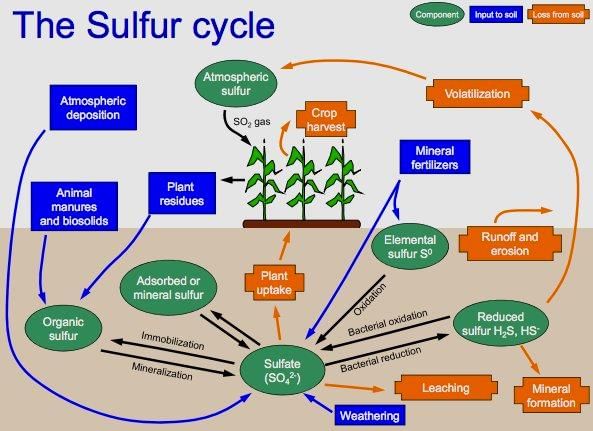
- It is released by weathering of rocks, erosional run-off and decomposition of organic matter and is carried to terrestrial and aquatic ecosystems in salt solution.
- The sulphur cycle is mostly sedimentary except two of its compounds hydrogen Sulphide (H2S) and sulphur dioxide (SO2) add a gaseous component to its normal Sedimentary cycle.
- Atmospheric sulphur dioxide is carried back to the earth after being dissolved in rainwater as weak sulphuric acid.
- Sulphur in the form of sulphates is take up by plants and incorporate through a series of metabolic processes into sulphur bearing amino acid which is incorporated in the proteins of autotroph tissues. It then passes through the grazing food chain.
- Sulphur bound in living organism is carried back to the soil, to the bottom of ponds and lakes and seas through excretion and decomposition of dead organic material.
Succession
- A universal process of directional change in vegetation, on an ecological time scale, occurs when a series of communities replace one another due to large scale destruction either natural or manmade.
- Continues one community replacing another community until a stable, mature community develops The first plant to colonise an area is called the pioneer community. The final stage of succession is called the climax community.
- The stage leading to the climax community are called successional stages or seres, characterised by the following: increased productivity, the shift of nutrients from the reservoirs, increased diversity of organisms with increased niche development, and a gradual increase in the complexity of food webs.
1. Primary Succession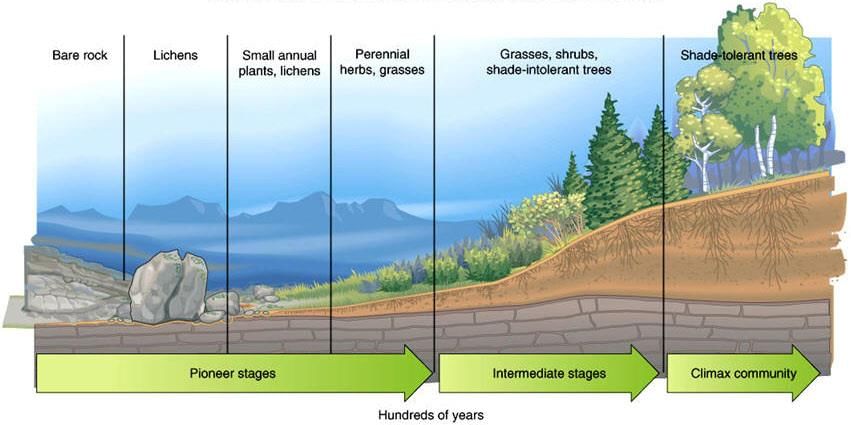 Primary succession
Primary succession
- In primary succession on a terrestrial site the new site is first colonized by a few hardy pioneer species that are often microbes, lichens and mosses. The pioneers through their death any decay leave patches of organic matter in which small animals can live.
- The organic matter produced by these pioneer species produces organic ads during decomposition that dissolve and etch the substratum releasing nutrients to the substratum. Organic debris accumulates in pockets and crevices, providing soil in which seeds can become lodged and grow.
- As the community of organisms continues to develop, it becomes more diverse and competition increases, but at the same time, new niche opportunities develop. The pioneer species disappear as the habitat conditions change and invasion of new species progresses, leading to the replacement of the preceding community.
2. Secondary Succession
- Occurs when plants recognize an area in which the climax community has been disturbed, is the sequential development of biotic communities after the complete or partial destruction of the existing community.
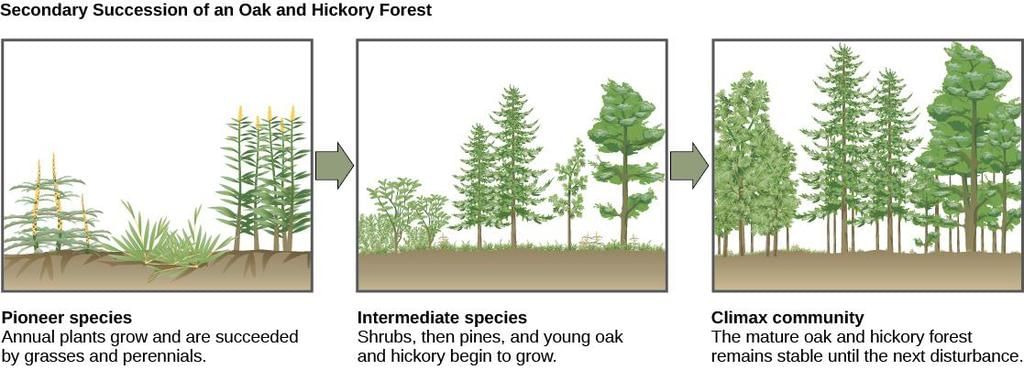
- This abandoned farmland is first invaded by hardy species of grasses that can survive in bare, sunbaked soil. These grasses may be soon joined by tall grasses and herbaceous plants. These dominate the ecosystem for some years along with mice, rabbits, insects and seed-eating birds.
- Eventually, some trees come up in this area, seeds of which may be brought by wind or animals. And over the years, a forest community develops. Thus abandoned farmland over a period becomes dominated by trees and is transformed into a forest.
- The differences between primary and secondary succession, the secondary succession starts on a well-developed soil already formed at the site. Thus secondary succession is relatively faster as compared to primary succession which may often require hundreds of years.
3. Autogenic and Allogenic Succession
- When succession is brought about by living inhabitants of that community itself, the process is called autogenic succession, while change brought about by outside forces is known as allogeneic succession.
4. Autotrophic and Heterotrophic succession
- Succession in which, initially the green plants are much greater in quantity is known as autotrophic succession; and the ones in which the heterotrophs are greater in quantity is known as heterotrophic succession.
- Succession would occur faster in area existing in the middle of the large continent. This is because, here all prop gules or seeds of plants belonging to the different series would reach much faster, establish and ultimately result in climax community.
|
780 videos|1299 docs|633 tests
|
FAQs on Shankar IAS Summary: Functions of An Ecosystem - Famous Books for UPSC Exam (Summary & Tests)
| 1. What is energy flow in an ecosystem? |  |
| 2. How do pollutants affect trophic levels in an ecosystem? |  |
| 3. What are some examples of biotic interactions in an ecosystem? |  |
| 4. What is a biogeochemical cycle in an ecosystem? |  |
| 5. How does succession occur in an ecosystem? |  |


























